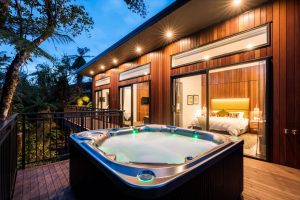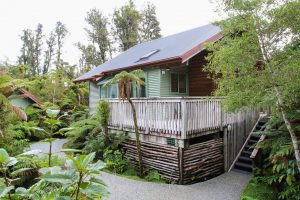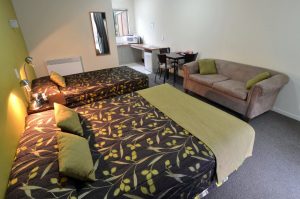Does the thought of glaciers invoke visions of cold temperatures, falling snow and crunchy ice?
The truth is, New Zealand’s Glacier Country enjoys fairly mild temperatures by global standards. Unlike the glacier regions of the Northern Hemisphere, Franz Josef Glacier and Fox Glacier don’t get the harsh winter conditions that would mean closing hiking operations over winter.
Thankfully, Franz Josef Glacier is open for business all year round. All you need to do is decide when you’re going to visit. Here are the pros and cons of visiting in the warm, cold, or rainy seasons.
Visiting Franz Josef during the colder months
Winter in New Zealand runs from June to August, and daytime temperatures sit between 5 and a pretty acceptable 15°C (41-57°F). Snow falls at the top of the glacier, but it’s unusual to see snow fall in the township of Franz Josef Glacier because of the low altitude and proximity to the coast.
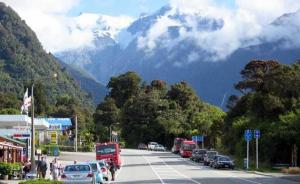
Busy times in the centre!
We checked in with a couple of glacier guides to ask them what they like about being on the glacier during winter and here’s what they had to say.
Reliable weather – The weather is generally more settled in winter. There are more clear days than other times of the year. You may have to put an extra layer on, but there is less chance that heli trips will be cancelled due to bad weather.
Catch the ice features – During the colder months, there is less melt occurring on the glacier, so there is less water flowing under the glacier to make it slide down the mountain. Because there is less movement, theamazing ice features of the glacier, like crevasses and ice caves, hang around for longer.
Quiet days – Visiting in the colder months, you can avoid the crowds on the glacier and around town. The summer months of November to February are the peak tourist season.
Thinking of visiting Franz Josef in winter? Put on an extra layer and get out there and enjoy it.
Visiting Franz Josef during the warmer months
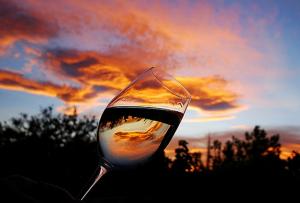
Sundowners on Rainforest Retreat’s deck
It’s true that the West Coast receives a lot of rain. But you may be surprised to hear that the area also receives up to 1,860 sunshine hours annually, making it one of New Zealand’s sunnier destinations. And in the Southern Hemisphere, sunshine hours go a long way. In the peak of summer, the sun is shining from 5.30am to 10pm.
Daytime temperatures range from 12°C and 25°C, making it perfect weather for exploring. The area offers a limitless supply of outdoor adventures to be had. You can try rainforest trekking, beach walking, glacier hiking, a trip to Lake Matheson or mountain climbing to name just a few.
We asked our expert glacier guides again what they liked about the summer months.
Sun’s out, guns out – Hiking on the ice in a pair of crampons will get the blood flowing. So, you’ll be able to take off a few layers and enjoy the novelty of walking on ice while wearing a t-shirt. Makes for a great photo!
Sundowners – What’s not to like about a few quiet sundowners on the deck on a warm summer’s evening?
Thinking of visiting Franz Josef in summer? Pack the sunscreen and the sunglasses and get out there!
Visiting Franz Josef during rainy season
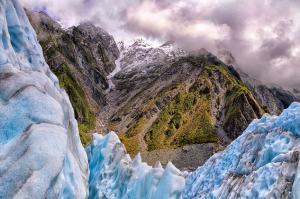
Winter at the Glacier
There’s no avoiding this one! Located in the South Island’s lush Westland Tai Poutini National Park, Franz Josef Glacier receives 6 – 8 metres of rainfall per year. That’s a lot of rain, so we try not to let a wet weather day stop us.
There are plenty of positives for exploring the West Coast on a rainy day.
Where there’s rain, there’s snow – When it’s raining in Franz Josef township, it means it’s snowing on the neve (the snowfield that feeds the glacier). And that’s good news for the glacier.
Waterfalls with a wow factor – On rainy days, the waterfalls are super-sized. New waterfalls appear from the steep sides of the glacier, and the permanent waterfalls are roaring and cascading, making an impressive sight.
The rainforest comes alive – Shrouded in cloud and mist, the mighty mountains of the Southern Alps look magical with their peaks covered withwhite, wispy clouds. The deep green rainforest looks almost prehistoric, thriving on the torrential rain.
So, whatever the weather, there’s no reason to stay inside. Pack a rain jacket on a rainy day, an extra layer on a cold day and a good hat on a sunny day. And get out there!



